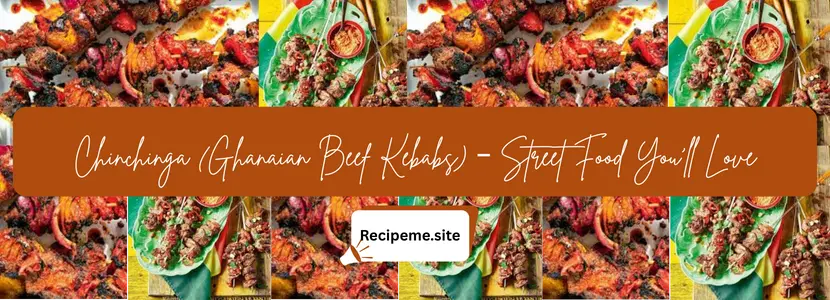
Introduction
Have you ever walked through a busy evening market and been stopped in your tracks by the smoky aroma of sizzling skewers? That’s the magic of Chinchinga (Ghanaian Beef Kebabs)—a street food favorite that has captured the hearts of Ghanaians for generations.
Whether you’re enjoying it at a festive gathering, a late-night roadside stall, or straight off a backyard grill, Chinchinga is more than just food—it’s a cultural experience. But what makes these beef kebabs so special? Is it the bold spice rub, the perfectly charred edges, or the way they bring people together? Let’s find out.
History of Chinchinga
The story of Chinchinga begins with the Hausa people of West Africa, known for their mastery of grilled meats. Similar dishes exist across the region, such as Nigeria’s Suya, but Ghana has given Chinchinga its own unique identity.
Introduced as a popular roadside snack, Chinchinga quickly became a staple at social events—weddings, festivals, and evening hangouts. Over time, its recipe evolved, with each region adding its own twist. Today, it’s not just a dish but a symbol of Ghanaian street food culture, connecting past and present through fire and flavor.
Essential Ingredients for Chinchinga
Authentic Chinchinga is all about simplicity balanced with bold spices. Here are the key ingredients:
-
Beef (sirloin or tender cuts) – the star of the dish.
-
Onions & Bell Peppers – for aroma and freshness.
-
Suya Spice (Kelewele-inspired mix) – a blend of ground peanuts, paprika, chili, ginger, and garlic powder.
-
Salt and Bouillon – for seasoning.
-
Oil (groundnut or vegetable) – helps spices stick and keeps the meat moist.
-
Wooden Skewers – traditionally grilled over open flame.
Did You Know? The spice rub for Chinchinga is often made with ground roasted peanuts, giving the kebabs a nutty undertone not found in many other barbecue styles.
Variations of Chinchinga
Like many beloved dishes, Chinchinga has countless variations:
-
Chicken Chinchinga – lighter, but equally flavorful.
-
Goat Meat Chinchinga – a popular choice at traditional gatherings.
-
Fish or Seafood Chinchinga – coastal regions sometimes use tilapia or shrimp.
-
Vegetable Chinchinga – for vegetarians, featuring mushrooms, plantains, or tofu.
Preparation: Step-by-Step Guide
Here’s how you can recreate Ghana’s famous beef kebabs at home.
Ingredients (serves 4):
-
500g beef (cut into cubes)
-
2 medium onions (sliced)
-
1 red bell pepper (cubed)
-
½ cup ground roasted peanuts
-
2 tbsp paprika
-
1 tbsp ground chili powder
-
1 tsp ginger powder
-
1 tsp garlic powder
-
2 tbsp vegetable oil
-
Salt and seasoning cube to taste
-
Wooden skewers (soaked in water if grilling)
Instructions:
-
Prepare the Spice Mix
-
In a bowl, combine ground peanuts, paprika, chili, ginger, garlic, and salt.
-
-
Season the Beef
-
Toss beef cubes in oil, then coat generously with the spice mix.
-
Marinate for at least 1–2 hours (overnight for deeper flavor).
-
-
Skewer the Meat
-
Alternate beef cubes with onions and bell peppers on skewers.
-
-
Grill or Roast
-
Grill over charcoal for smoky flavor, or bake in an oven at 200°C (390°F) until golden brown.
-
Turn skewers regularly for even cooking.
-
-
Serve Hot
-
Garnish with raw onion rings, kpakpo shito (green chili sauce), or spicy pepper dip.
-
Tip: For extra juiciness, brush the skewers with oil mixed with leftover spice rub while grilling.
Cultural Significance of Chinchinga
Chinchinga isn’t just street food—it’s a social tradition. In Ghana, these kebabs are a staple at:
-
Evening Gatherings: Friends catch up over drinks and Chinchinga at roadside grills.
-
Festivals: A must-have snack during music and cultural events.
-
Special Occasions: Weddings and naming ceremonies often feature skewers as part of the spread.
It symbolizes hospitality, community, and the joy of sharing good food.
Serving Suggestions
Chinchinga is versatile and can be enjoyed in many ways:
-
With fried plantains or kelewele for a sweet-spicy balance.
-
Alongside jollof rice for a hearty meal.
-
Served with chilled drinks as party snacks.
-
Paired with shito (Ghanaian black pepper sauce) for bold heat.
Types of Chinchinga
While beef is the most common, Chinchinga comes in several types:
-
Classic Beef Chinchinga – the traditional favorite.
-
Chicken Chinchinga – quicker to cook, lighter in flavor.
-
Mixed Chinchinga – combining meat with vegetables for variety.
-
Street-Side Chinchinga – smoky, spicy, and best enjoyed outdoors.
Tips for the Perfect Chinchinga
-
Use tender cuts of beef for best results.
-
Soak skewers in water before grilling to prevent burning.
-
Charcoal grilling enhances authenticity.
-
Don’t skip the peanut spice—it’s what makes Chinchinga unique.
-
Let the meat rest a few minutes after grilling to retain juices.
Other Valuable Insights
-
Nutritional Value: High in protein, with healthy fats from peanuts and essential vitamins from vegetables.
-
Hidden Fact: The word “Chinchinga” is believed to be a local adaptation of Hausa grilling traditions.
-
Cultural Note: Many vendors guard their spice mix recipes closely—it’s considered a family secret.
Personal Experience: My Journey with Chinchinga
The first time I tried Chinchinga was at a street corner in Accra. The smoky aroma drew me in, and within minutes I was holding a skewer fresh off the grill. The crunch of roasted peanuts mixed with the heat of chili and the tenderness of the beef was unforgettable. What struck me most wasn’t just the taste, but the experience—the laughter, the music, and the sense of community around that roadside grill. That day, I realized Chinchinga is more than food; it’s a cultural heartbeat.
Conclusion
Chinchinga (Ghanaian Beef Kebabs) is the perfect blend of tradition, flavor, and togetherness. From its Hausa roots to its place as Ghana’s favorite street snack, it has stood the test of time as a dish that unites people.
So, whether you’re hosting friends, planning a family meal, or craving a taste of Ghana, try making Chinchinga—you’ll fall in love with every bite.
Frequently Asked Questions
1. What is Chinchinga made of?
Chinchinga is made of beef cubes marinated in a peanut-based spice mix, skewered with onions and peppers, and grilled or roasted.
2. Is Chinchinga the same as Suya?
They are similar but not identical. Suya is Nigerian, while Chinchinga is Ghanaian, with subtle differences in spice blends and presentation.
3. Can Chinchinga be made without peanuts?
Yes, but peanuts give it its signature flavor. Without them, the taste will be less authentic.
4. What is the best meat for Chinchinga?
Tender cuts of beef like sirloin or flank work best, but goat or chicken can also be used.
5. How do I make Chinchinga at home without a grill?
You can bake in the oven or pan-sear skewers on a stovetop grill pan.
6. What side dishes go well with Chinchinga?
Fried plantains, jollof rice, shito sauce, or even fresh salad pair wonderfully with Chinchinga.
